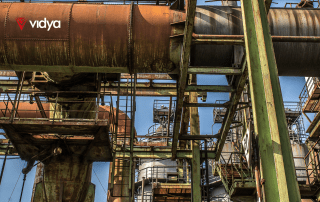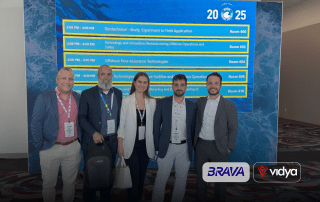Beyond corrosion detection: How is Vidya’s System being used?
Corrosion. AI. Digital Twin. You already know that the Vidya System Platform (VSP) stands out in these disciplines. But what started as a corrosion-focused platform quickly became a versatile system for understanding and managing complex industrial realities. Its evolution reflects how technology and user demands continue to shape one another. But what else is possible to do within Vidya’s solution? Well, we asked our clients how they are using the VSP. Janaina Albino and Stefany Batista, Delivery and Customer Success Team From detecting corrosion to operating with ease Born as a corrosion-targeted solution, the scope and capabilities [...]
Integridad de FPSOs 101: retos, estrategias y el rumbo a seguir
Los FPSO (Floating Production, Storage, and Offloading units, por sus siglas en inglés) se encuentran en la intersección entre la ingeniería extrema y la estrategia económica a largo plazo. Su presencia en aguas marítimas profundas viabiliza la extracción de gas y petróleo en lugares donde la infraestructura fija sería inviable. En estos activos industriales, cada componente de la embarcación está continuamente expuesto a condiciones severas de las profundidades del mar, fatiga estructural, cargas variables y esfuerzos mecánicos. Sumado a ello, la corrosión ataca lentamente los cascos, risers y equipos de topside. Los movimientos repetitivos de las olas y las tensiones [...]
What Is Structural Integrity Management and Why Does It Matter
Structural Integrity Management (SIM) refers to the systematic process of ensuring that a physical asset, whether a pipeline, offshore platform, storage tank, bridge, or structural frame, retains sufficient strength, stiffness, and safety margins over its intended life, under both normal and extreme loads, environmental degradation, and operational changes. It is not just a one-off check; instead, Structural Integrity Management spans all phases of an asset’s life: design, fabrication, construction, commissioning, operation, and decommissioning. In essence, structural integrity combines inspection, monitoring, modeling, assessment, and maintenance planning to detect, evaluate, mitigate, or prevent structural damage, fatigue, corrosion, defects, or other forms of [...]
Beyond Compliance: Integrating Process Safety and Asset Integrity in Offshore Oil & Gas
The evolution of safety in offshore oil and gas operations is closely tied to global advancements in safety culture, legislation, and best practices. A major turning point in offshore safety history was the shift from prescriptive, equipment-focused laws to performance-based and self-regulatory frameworks that emphasize systemic risk management, asset integrity, and human factors. From Frameworks to Function: Why Process Safety Became Central As offshore operations grew in complexity, the limitations of traditional safety models became clear. Regulatory evolution set the stage, but it was the industry's increasing awareness of systemic vulnerabilities that pushed for a deeper, more technical [...]
5 Steps to Strengthen Your Static Equipment Compliance Strategy
In large-process industries, static equipment such as pressure vessels, piping, and storage tanks represents the majority of operational machinery. While these assets may not move or rotate like pumps or turbines, their failure can be equally catastrophic, leading to safety incidents, production losses, and regulatory penalties. Understanding the nature and function of these assets is the first step toward building a robust and auditable integrity management framework. And, given the scale of risk involved, ensuring the integrity of static equipment is both a regulatory obligation and a strategic necessity. But what exactly qualifies as static equipment? And why does its [...]
Vidya Expands Digital Integrity Management to New Markets with Scalable Technology
Curitiba, June 13th, 2025 Vidya Technology announces the launch of its Digital Asset Integrity Management Suite, a set of integrated tools that enables full control over the integrity lifecycle from detection to resolution. Combining Artificial Intelligence, Digital Twins, and Spatial Computing, the new solution delivers a contextualized, end-to-end visualization of physical assets, allowing faster and better-informed decisions while enhancing safety, reducing downtime, and cutting operational costs. Originally founded at COPPE/UFRJ, Vidya has become a recognized player in offshore software solutions. Its visual inspection automation technology, which uses computer vision to measure and classify surface corrosion, currently holds 57% of the [...]
FPSO Integrity 101: Challenges, Strategies, and the Path Forward
FPSOs (Floating Production, Storage, and Offloading units) sit at the intersection of extreme engineering and long-term economic strategy. Their presence in deep and remote offshore fields enables oil and gas production in places where fixed infrastructure would be impossible. Every component of the vessel is continuously exposed to harsh saltwater conditions, structural fatigue, variable loads, and mechanical stress. Corrosion slowly attacks hulls, risers, and topside equipment. Repetitive motions induced by waves and mooring tensions generate fatigue in welded joints and critical structures. And over time, these forces accumulate. And yet, many operators still treat integrity as a secondary concern [...]
The cost of Ineffective Asset Integrity Management
When a pipe leaks, it’s rarely just a leak. In complex industrial operations, small issues often signal deeper inefficiencies, and when these signals are ignored or mismanaged, the consequences can escalate quickly. From unplanned shutdowns to environmental and reputational damage, the cost of ineffective Asset Integrity Management (AIM) can be staggering. In an industry that depends on reliability and compliance, treating asset integrity as multiple, diffuse tasks rather than a structured, data-driven process is no longer sustainable. Yet, many operators still rely on fragmented systems that hinder decision-making and delay action. But what does it mean to manage asset integrity, [...]
Vidya and BRAVA Energia Present Paper at OTC Houston: A New Chapter in Corrosion and Integrity Management
This year, at the Offshore Technology Conference (OTC) in Houston, a new benchmark was set for offshore asset maintenance and corrosion control. Vidya, in collaboration with BRAVA Energia, presented a technical paper exploring a game-changing approach to the industry’s enduring challenge: reducing the risk of corrosion while optimizing operational efficiency in brownfields. Titled "Digitalization of the Corrosion Identification Process Using Digital Technologies in Mature Fields", the paper was co-authored by teams from Vidya and BRAVA Energia, including: Lincon D’Aquila, Integrity and Maintenance Manager at Brava, Otavio Correa, Vidya’s CEO, Jorge Mariano, Vidya’s VP US, and André Andrade, Marketing [...]
Regulatory Compliance in Asset Integrity: What You Need to Know
In large-process industries, entire facilities operate under conditions of high pressure, high temperature, and elevated risk. Within this context, regulatory compliance is not a bureaucratic obligation—it is a technical imperative. Asset integrity, safety, and operational continuity depend on how well facilities meet and maintain regulatory standards, particularly for pressure-retaining equipment and critical infrastructure. This blog explores why Asset Integrity requires regulatory compliance and how operations can benefit from being transparent and compliant. Why Asset Integrity Requires Regulatory Compliance Maintaining the structural integrity of equipment such as pressure vessels, storage tanks, and interconnecting piping systems is essential for mitigating [...]
![Image of a woman using Vidya System Platforms [VSP] on a tablet.](https://vidyatec.com/wp-content/uploads/2025/11/1-capa-blog-CS@2x-320x202.png)








